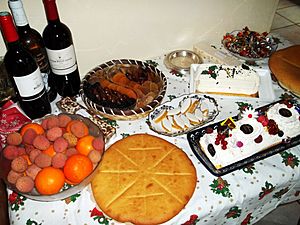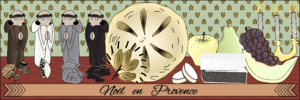Thirteen desserts facts for kids
The thirteen desserts (in Occitan: lei tretze dessèrts) are special sweet foods. They are a traditional part of Christmas celebrations in the French region of Provence. This tradition is very old and important to many families there.
These desserts are served after a big Christmas Eve meal called le gros souper. There are always exactly thirteen desserts. They represent Jesus Christ and his 12 apostles. The types of desserts can be a little different from one family to another. But there are always thirteen of them! People usually put the desserts out on Christmas Eve. They stay on the table for three days, until December 27.
The Four Beggars
Among the thirteen desserts, four are very special. They are known as the "four beggars" (les quatre mendiants). These four foods represent four old groups of monks. These monks were called mendicant orders. They were the Dominicans, Franciscans, Augustinians, and Carmelites.
- Raisins stand for the Dominicans.
- Walnuts or hazelnuts stand for the Augustinians.
- Dried figs stand for the Franciscans.
- Almonds stand for the Carmelites.
Other dried fruits are also part of the tradition. These include dates. Dates represent the foods from the area where Jesus lived. You might also find dried plums from a town called Brignoles.
Fresh and Juicy Fruits
Fresh fruits are a refreshing part of the thirteen desserts. They add color and natural sweetness to the table.
Common fresh fruits include:
- Apples
- Pears
- Oranges
- Winter melon (a type of squash)
- Grapes
- Tangerines
Sweet Treats and Candies
Many different sweet treats are also part of the thirteen desserts. These delicious items add a lot of variety to the Christmas table.
Some popular sweets are:
- Biscotins, which are small biscuits from a city called Aix.
- Calissons d'Aix, a special candy that tastes a bit like marzipan. It is made from almond paste and candied melon.
- Candied citron, which is a sweet, preserved citrus fruit.
- Casse-dents of Allauch, another type of biscuit.
- Biscuits flavored with cumin and fennel seed.
- Fried bugnes, which are light, crispy pastries.
- Fruit tourtes, which are sweet fruit tarts.
- Oreillettes, very thin and light waffles.
- Pain d'epices, a type of spice bread.
- Pompes à l'huile or fougasse à l'huile d'olive. This is a sweet cake or brioche made with orange flower water and olive oil.
- Quince cheese or quince paste (called Pâte de coing). This is a firm, sweet jelly made from quince fruit.
- Yule log, a cake shaped like a log, often decorated for Christmas.
- Two kinds of nougat, which are candies made with honey and nuts. These two types of nougat are said to represent good and evil.
- Black nougat (Nougat noir au miel) is a hard candy. It is made with honey and almonds.
- White nougat (Nougat blanc) is a soft candy. It is made with sugar, eggs, pistachios, honey, and almonds.
See also
 In Spanish: Trece postres para niños
In Spanish: Trece postres para niños



